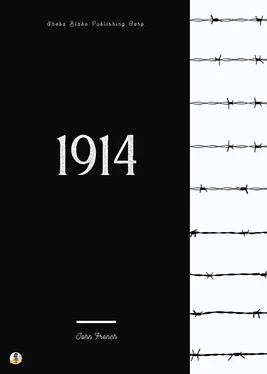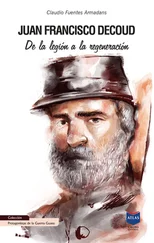Reports of German activity on his front continued to be received from the G.O.C. 2nd Corps. At 7.15 p.m. he asked for permission to retire on Bavai; at 9.45 he was again reassured—a Divisional Headquarters which had retired was now “moving forward again”; and at 10.20 p.m. he reported, “casualties in no way excessive; all quiet now.”
The line which the 2nd Corps had taken up for the night showed an average retirement of three miles south of the canal. During the late afternoon the advanced troops of the 1st Corps were engaged, but not seriously threatened; they held their ground.
During the late afternoon and evening very disquieting reports had arrived as to the situation on my right. These were confirmed later in a telegram from French Headquarters, which arrived at half-past eleven at night. It clearly showed that our present position was strategically untenable; but this conclusion had been forced upon me much earlier in the evening when I received a full appreciation of the situation as it then appeared at French General Headquarters. General Joffre also told me that his information led him to expect that I might be attacked the next day by at least three German Corps and two Cavalry Divisions.
Appreciating the situation from the point of view which all reports now clearly established, my last hope of an offensive had to be abandoned, and it became necessary to consider an immediate retreat from our present forward position.
I selected the new line from Jerlain (south-east of Valenciennes) eastwards to Maubeuge. This line had already been reconnoitred. The Corps and Divisional Staff Officers who were called into Headquarters to receive orders, especially those of the 2nd Corps, thought our position was much more seriously threatened than it really was and, in fact, one or two expressed doubts as to the possibility of effecting a retirement in the presence of the enemy in our immediate front. I did not share these views, and Colonel Vaughan (Chief of the Staff of the Cavalry Division) was more inclined to accept my estimate of the enemy’s forces on or near the canal than the others were. His opportunities of gauging the enemy’s strength and dispositions had been greatly enhanced by the fine reconnoitring work done on the previous two or three days by the Cavalry Division. However, I determined to effect the retreat, and orders were issued accordingly.
The 1st Army Corps was to move up towards Givry and to take up a good line to cover the retreat of the 2nd Corps towards Bavai, which was to commence at daybreak. Our front and left flank was to be screened and covered by the cavalry and the 19th Infantry Brigade.
At about 1 a.m. on the 24th, Spiers came in from the Headquarters of the 5th French Army and told me that they were seriously checked all along the line. The 3rd and 4th French Armies were retiring, and the 5th French Army, after its check on Saturday, was conforming to the general movement.
The information previously referred to as arriving from French Headquarters at 11.30 p.m. on the 23rd was as follows:—
1. Namur fell this day.
2. The 5th French Army had been attacked all along their front by the 3rd German Corps, the Guard, the 10th and 7th Corps, and was falling back on the line Givet—Philippeville—Maubeuge.
3. Hastière had been captured by the Germans on the 23rd.
4. The Meuse was falling rapidly and becoming fordable in many places, hence the difficulty of defence.
At 5.30 a.m. on the 24th I went out to my advanced Headquarters, which had been established at Bavai, a small village which is strategically important from the circumstance that it is the meeting place of roads from every point of the compass. The orders issued through the night had been carried out. The 1st Corps was on the line Nouvelles—Harmignies—Givry, with Corps Headquarters at Bonnet. They were making an excellent stand to cover the retirement of the 2nd Corps, which was being hard pressed, particularly the 5th Division to the south-east of Condé. In fact, at 10 a.m. General Fergusson, Commanding the Division, found it necessary to call very urgently upon General Allenby for help and support. The 19th Infantry Brigade under Drummond had, it will be remembered, been placed at the disposal of the commander of the Cavalry Division, who, calling this Brigade up in immediate support of the 5th Division, directed Gough’s 3rd and De Lisle’s 2nd Cavalry Brigades (3rd Cavalry Brigade: 4th Hussars, 5th Lancers, and 16th Lancers; 2nd Cavalry Brigade: 4th Dragoon Guards, 9th Lancers, and 18th Hussars) to threaten and harass the flanks of the advancing German troops, whilst Bingham’s 4th Cavalry Brigade remained in observation towards the west.
The intervention of Allenby and Drummond, and the support they rendered, was most effective in taking the severe pressure of the enemy off the 5th Division and enabling it to continue its retreat. About 11.30 a.m. the 2nd Corps Headquarters were retired from Sars-la-Bruyère to Hon.
Soon after arriving at Bavai I visited the Headquarters of the 1st Corps at Bonnet and observed the fighting above mentioned. Our troops in this part of the line were very active and pushing. The 8th Brigade under Davies (2nd Batt. Royal Scots, 2nd Batt. Royal Irish Regt., 4th Batt. Middlesex Regt. and 1st Batt. Gordon Highlanders) was now at Nouvelles, on the left; then came the rest of the 2nd Division, and then the 1st Division under Lomax, on the right.
I went out from Haig’s Headquarters to a high ridge, whence the ground slopes down towards the north and north-east, along a gentle declivity stretching almost to the canal which was some distance away. The situation of the 1st Corps was excellent, and the artillery positions were well chosen. From where we stood we could observe the effect of our fire. It was very accurate, and shrapnel could be seen bursting well over the enemy lines and holding his advance in complete check, whilst the German fire was by no means so effective. The infantry were defending their position a long way down the slope with great determination and tenacity. The steadfast attitude and skilful retreat of our right wing at Mons had much to do with the success of our withdrawal, and the short time I spent with the 1st Corps that morning inspired me with great confidence.
The subsequent retirement of the 1st Corps was carried out successfully and with little loss, Haig’s Headquarters being established at Riez de l’Erelle at about 1 p.m.
After visiting some important points in the field over which the 2nd Corps was fighting, I determined to seek out General Sordet, Commanding the French Cavalry Corps, which was in cantonments somewhere to the east of Maubeuge. I found Sordet’s Headquarters at Avesnes. The scene in the village was very typical of continental war as it has been so often presented to us in pictures of the war of 1870.
The Commander of the French Cavalry Corps and his Staff, whom I met in the central square, formed a striking group against a very suitable background of gun parks and ammunition wagons. One looked in vain for the fire-eating beau sabreur of a Murat.
The man who had come back from that first desperate onslaught in Belgium, and had so grandly supported and succoured our hard-pressed Allies in their splendid defence, was a very quiet, undemonstrative, spare little figure of at least 60 years of age. He appeared hard and fit, and showed no sign of the tremendous strain he had already undergone. On the contrary, he was smart and dapper, and looked like the light-weight horseman he is. His clear-cut face and small, regular features, denoted descent from the old noblesse , and he struck me in his bright tunic as one who might be most fittingly imaged in a piece of old Dresden china; but added to all this was the bearing of a Cavalry Commander.
Читать дальше












